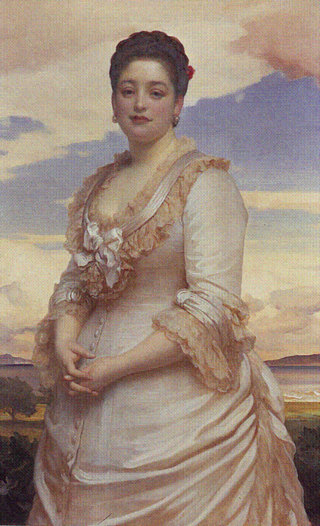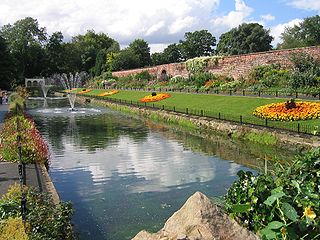
Prince of Wales Drive is a street in Battersea, in the London borough of Wandsworth. It is situated on the southern perimeter of Battersea Park.

Prince of Wales Drive is a street in Battersea, in the London borough of Wandsworth. It is situated on the southern perimeter of Battersea Park.


The southern side of Prince of Wales Drive is lined with late-Victorian mansion blocks and villas. From Battersea Bridge Road, east to Queenstown Road, the building order is as follows:
This section needs additional citations for verification .(July 2024) |
In 1846, the Commission for Improving the Metropolis acquired 320 acres of Battersea Fields, of which 198 acres became Battersea Park, and the remainder was to be let on building leases—the area now covered by Prince of Wales Drive, which was previously known as Prince of Wales Road, was part of Battersea Fields. The road was named after the then Prince of Wales, who would become King Edward VII in 1901; the roads on the east and west sides of the park were named after his mother and father respectively.
The original idea was for Battersea Park to be surrounded by middle-class villas, as seen in other contemporary parks in Britain. Land was allocated for building, but nothing was built for about 30 years. One villa, Carlton Lodge, was built in 1884.
In the 1890s Cyril Flower, 1st Baron Battersea, began to acquire vacant land on the south side of Prince of Wales Drive from the Commissioners for Development. His first mansion block to be developed along Prince of Wales Drive was Overstrand Mansions, which was begun on 11 January 1893. In 1894, most of the other mansion blocks were begun by Cyril Flower: Cyril Mansions was started on 26 April; Norfolk Mansions was started on 27 October; and both Sidestrand Mansions (now Park Mansions) and Primrose Mansions were started in November. These blocks were under construction, by different builders, at much of the same time, and are of an architecture style inspired by the Arts and Crafts Movement. The leases for these buildings were taken up with enthusiasm when built.
The names of these five mansion blocks were selected by Cyril Flower, and his wife Constance. Sidestrand Mansions (now Park Mansions), Norfolk Mansions and Overstrand Mansions were named after "Poppyland", which was popularised by Clement Scott, the theatre critic for The Daily Telegraph . "Poppyland" was a fashionable holiday destination during this time, and the names would have appealed to the first residents of Prince of Wales Drive. Cyril Mansions was named by Cyril Flower after himself, and Primrose Mansions was named after Constance's Rothschild cousin, Hannah, who was married to Archibald Primrose, Earl of Rosebery (Rosebery Villa abuts Primrose Mansions on Alexandra Road).
York Mansions and Prince of Wales Mansions were constructed a few years later, and were built on the reclaimed land from The Albert Palace.
The composer and musician Donald Swann lived for a while in Prince of Wales Drive, then Albert Bridge Road where a blue plaque has been placed.
In 1906, 69 Primrose Mansions was in the possession of Mrs Edith Karno, the estranged wife of comedy impresario Fred Karno. From here, with a number of Music Hall friends, she helped to run the first office of the Ladies Music Hall Guild—founded in September 1906 with Marie Lloyd as its president. Edith Karno was its first treasurer. [1]
On Wednesday, 13 July 1910, Frederick Anderson and Elizabeth Earle heard two gunshots ring out from the neighboring garden flat, number 17 Prince of Wales Drive Mansions. Frederick, who was visiting Elizabeth, went to investigate, saw a body, and called the police. He recognised the body to be his father upon arrival of the police.
Frederick's father, Thomas Weldon Atherston, was an actor who went under the stage name of Weldon Atherston. Thomas had previously had an affair with Elizabeth Earle in 1899; she had been a young struggling actress when she had the affair. After the affair was over, Thomas' son, Frederick, and Elizabeth became friends.
The murder remains a mystery, and it is not known why Thomas Anderson was in the adjoining garden flat to Elizabeth Earle. Some surmise that he was spying on his son and ex-girlfriend.

Cromer is a coastal town and civil parish on the north coast of the English county of Norfolk. It is 23 miles north of Norwich, 116 miles north-northeast of London and four miles east of Sheringham on the North Sea coastline. The local government authorities are North Norfolk District Council, whose headquarters is on Holt Road in the town, and Norfolk County Council, based in Norwich. The civil parish has an area of 4.66 km2 and at the 2011 census had a population of 7,683.

Archibald Philip Primrose, 5th Earl of Rosebery, 1st Earl of Midlothian, was a British Liberal Party politician who served as Prime Minister of the United Kingdom from March 1894 to June 1895. Between the death of his father, in 1851, and the death of his grandfather, the 4th Earl of Rosebery, in 1868, he was known by the courtesy title of Lord Dalmeny.

Regent's Park is one of the Royal Parks of London. It occupies 410 acres (170 ha) in north-west Inner London, administratively split between the City of Westminster and the Borough of Camden. In addition to its large central parkland and ornamental lake, it contains various structures and organizations both public and private, generally on its periphery, including Regent's University and London Zoo.

Hannah Primrose, Countess of Rosebery was the daughter of Baron Mayer de Rothschild and his wife Juliana. After inheriting her father's fortune in 1874, she became the richest woman in Britain. In 1878, Hannah de Rothschild married Archibald Primrose, 5th Earl of Rosebery, and was thereafter known as the Countess of Rosebery.

Battersea Park is a 200-acre (83-hectare) green space at Battersea in the London Borough of Wandsworth in London. It is situated on the south bank of the River Thames opposite Chelsea and was opened in 1858.

Roundhay is a large suburb in north-east Leeds, West Yorkshire, England. Roundhay had a population of 22,546 in 2011.

Potts Point is a small and densely populated suburb in inner-city Sydney, New South Wales, Australia. Potts Point is located 2 kilometres (1.2 mi) east of the Sydney central business district and is part of the local government area of the City of Sydney.

The Italianate style was a distinct 19th-century phase in the history of Classical architecture. Like Palladianism and Neoclassicism, the Italianate style combined its inspiration from the models and architectural vocabulary of 16th-century Italian Renaissance architecture with picturesque aesthetics. The resulting style of architecture was essentially of its own time. "The backward look transforms its object," Siegfried Giedion wrote of historicist architectural styles; "every spectator at every period—at every moment, indeed—inevitably transforms the past according to his own nature."

Overstrand is a village on the north coast of Norfolk in England, two miles east of Cromer. It was once a modest fishing station, with all or part of the fishing station being known as Beck Hythe. In the latter part of the 19th century it was catapulted into prominence, and became known as “the village of millionaires”.
The Norfolk and Suffolk Joint Railway (NSJR) was a British joint railway company.

Thomas Weldon Anderson, known professionally as Thomas Weldon Atherstone, was an English music hall star and victim of an unsolved murder. His body was found in a backyard, at the base of a staircase leading up to the flat of his former lover, at Clifton Gardens, 17 Prince of Wales's Road, Battersea - now Prince of Wales Drive - on 16 July 1910. In 1888, he married the Irish actress Monica Kelly in Salford.
Frederick Thomas Pilkington (1832-1898), pupil of his father, was a "Rogue" British architect, practising in the Victorian High Gothic revival style. He designed mostly churches and institutional buildings in Scotland. Typical of his work is the Barclay Viewforth Church in Edinburgh, a polychrome stone structure with early French Gothic details.

Tagg's Island is an ait (island) on the River Thames on the reach above Molesey Lock and just above Ash Island, located in the London Borough of Richmond upon Thames and part of Hampton. The island is roughly 400 metres long by 90 metres wide at its widest point, covering 6 acres. Although close to the Surrey bank near East Molesey, the island is connected to the further Middlesex bank by a single track road bridge, being the only island on the non-tidal Thames accessible by car.

Cyril Flower, 1st Baron Battersea was a British Liberal politician and patron of art.

The Paston Way is a footpath. It is entirely within the English county of Norfolk in the United Kingdom. The footpath is twenty miles in length, the portals to the path are Cromer at its northwestern end and North Walsham at it southeastern end.

The Albert Palace was a large building located in Battersea, in the borough of Wandsworth, London. It faced, and formed a backdrop to the lake in Battersea Park, and was a re-erection of an iron and glass structure, like The Crystal Palace of 1851, which had partly housed the Dublin International Exhibition of 1865.

York Mansions is one of the seven Victorian blocks of flats on Prince of Wales Drive, London, between Albert Bridge Road and Queenstown Road, in Battersea, in the London borough of Wandsworth. The four-storey building is portered.

Edward Boardman (1833–1910) was a Norwich born architect. He succeeded John Brown as the most successful Norwich architect in the second half of the 19th century. His work included both civic and ecclesiastical buildings, in addition to private commissions. Together, with his rival, George Skipper, he produced many notable buildings with several standing to this day (2013).

Constance Flower, Baroness Battersea, also known as Lady Battersea, was a society hostess and philanthropist in London who established the Jewish Association for the Protection of Girls, Women and Children in 1885 and was prominent in the Temperance movement in the United Kingdom.

Avenue Road is a street in the Swiss Cottage and St John's Wood districts of London, known for having some of the highest home property prices in the United Kingdom. The street is popular with buyers who have replaced older houses with large mansions.